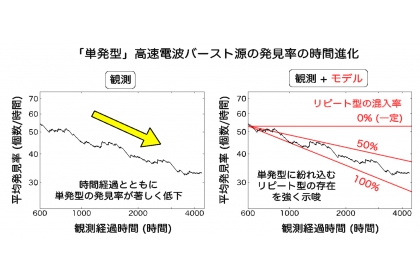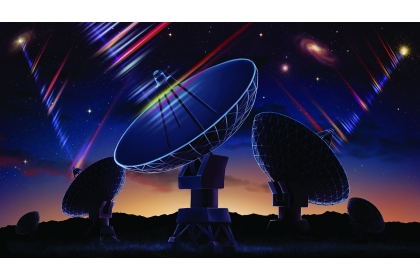First Global Confirmation: Over Half of Fast Radio Bursts Are Repeating
2025-03-25
興新聞張貼者
Unit秘書室
1,210
Fast Radio Bursts (FRBs) are among the most mysterious astronomical phenomena in the universe. They are classified into two types: repeating FRBs, which occur multiple times, and one-off FRBs, which happen only once. Until now, the prevailing belief in the scientific community has been that one-off FRBs are the majority, while repeating FRBs are relatively rare. However, a research team jointly formed by the Department of Physics at National Chung Hsing University (NCHU) and National Tsing Hua University (NTHU) has presented a groundbreaking finding at the annual meeting of the Astronomical Society of Japan this March, overturning conventional understanding. Their study confirms that more than half of all FRBs are repeating, providing a new direction for research into the origins of these cosmic signals.
The research team includes Shotaro Yamasaki, a National Science and Technology Council (NSTC) researcher at NCHU and the first author of the study; Tetsuya Hashimoto, an associate professor at NCHU’s Department of Physics; Tomo Goto, a professor at NTHU’s Institute of Astronomy; and Chih-Teng Ling, a PhD student at NTHU’s Institute of Astronomy.
According to Shotaro Yamasaki, when astronomers observe the night sky using radio telescopes, they detect mysterious flashes of light that last only a few milliseconds—these are known as Fast Radio Bursts. More than a thousand FRBs occur daily throughout the universe. It is generally believed that repeating FRBs originate from phenomena that can be triggered multiple times, such as flares from highly magnetized neutron stars, while one-off FRBs are thought to be associated with cataclysmic events like the merger of binary star systems (two stars orbiting each other). Therefore, correctly distinguishing between these two types of FRBs is crucial for solving the mystery of their origin.
Due to the limitations of radio telescopes, which can only observe a given region of the sky for a short period each day, repeating FRBs that occur outside of observation windows may be missed, leading to their misclassification as one-off FRBs. The research team hypothesized that the proportion of repeating FRBs has been significantly underestimated and set out to determine their true occurrence rate.
Using publicly available data from the Canadian Hydrogen Intensity Mapping Experiment (CHIME) radio telescope, the team analyzed the detection rate of one-off FRBs over time. They found that the discovery rate of one-off FRBs decreases significantly over extended observation periods. Between 600 and 4,000 hours of observation, the detection rate dropped by about half—suggesting that many one-off FRBs were later reclassified as repeating FRBs after additional observations.
To verify their findings, the team developed a theoretical model for FRBs and conducted statistical analyses. The results showed that, with 99% confidence, more than 50% of all FRBs are repeating. At a 95% confidence level, the study suggests that nearly 100% of FRBs could be of the repeating type.
In the past, because most observed FRBs appeared to be one-off events, astronomers generally believed they originated from explosive astrophysical events like neutron star mergers. However, this new research clearly indicates that the vast majority of FRBs actually originate from astrophysical objects capable of producing repeating bursts, such as neutron star flares. This discovery marks a significant step forward in our understanding of FRB origins. Moving forward, the research team aims to further investigate the properties and mechanisms of repeating FRBs in hopes of ultimately uncovering the true nature of these enigmatic cosmic signals.
The research team includes Shotaro Yamasaki, a National Science and Technology Council (NSTC) researcher at NCHU and the first author of the study; Tetsuya Hashimoto, an associate professor at NCHU’s Department of Physics; Tomo Goto, a professor at NTHU’s Institute of Astronomy; and Chih-Teng Ling, a PhD student at NTHU’s Institute of Astronomy.
According to Shotaro Yamasaki, when astronomers observe the night sky using radio telescopes, they detect mysterious flashes of light that last only a few milliseconds—these are known as Fast Radio Bursts. More than a thousand FRBs occur daily throughout the universe. It is generally believed that repeating FRBs originate from phenomena that can be triggered multiple times, such as flares from highly magnetized neutron stars, while one-off FRBs are thought to be associated with cataclysmic events like the merger of binary star systems (two stars orbiting each other). Therefore, correctly distinguishing between these two types of FRBs is crucial for solving the mystery of their origin.
Due to the limitations of radio telescopes, which can only observe a given region of the sky for a short period each day, repeating FRBs that occur outside of observation windows may be missed, leading to their misclassification as one-off FRBs. The research team hypothesized that the proportion of repeating FRBs has been significantly underestimated and set out to determine their true occurrence rate.
Using publicly available data from the Canadian Hydrogen Intensity Mapping Experiment (CHIME) radio telescope, the team analyzed the detection rate of one-off FRBs over time. They found that the discovery rate of one-off FRBs decreases significantly over extended observation periods. Between 600 and 4,000 hours of observation, the detection rate dropped by about half—suggesting that many one-off FRBs were later reclassified as repeating FRBs after additional observations.
To verify their findings, the team developed a theoretical model for FRBs and conducted statistical analyses. The results showed that, with 99% confidence, more than 50% of all FRBs are repeating. At a 95% confidence level, the study suggests that nearly 100% of FRBs could be of the repeating type.
In the past, because most observed FRBs appeared to be one-off events, astronomers generally believed they originated from explosive astrophysical events like neutron star mergers. However, this new research clearly indicates that the vast majority of FRBs actually originate from astrophysical objects capable of producing repeating bursts, such as neutron star flares. This discovery marks a significant step forward in our understanding of FRB origins. Moving forward, the research team aims to further investigate the properties and mechanisms of repeating FRBs in hopes of ultimately uncovering the true nature of these enigmatic cosmic signals.




